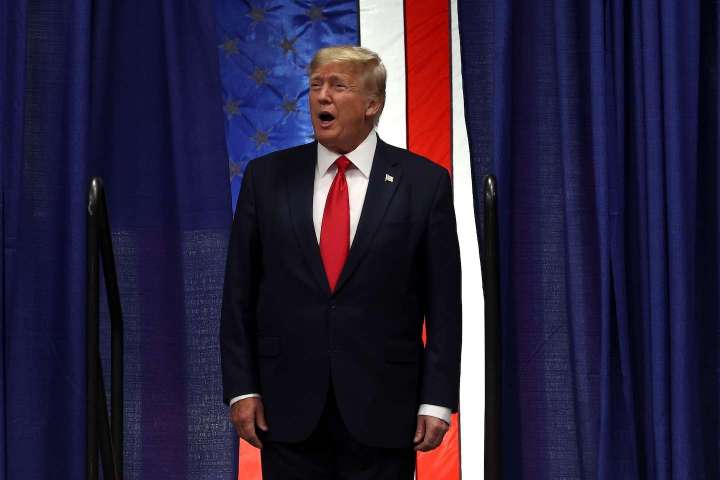Former president Donald Trump says he has made a decision about whether to run in 2024, though he won’t say when he will announce it. But he warns that if he does run, there will be a “backlash” against anyone who challenges him for the nomination. “People want me to run,” he says.
Trump should hope for a crowded 2024 GOP field. Really.

Fewer and fewer. In October 2021, a Quinnipiac University poll found that an overwhelming 78 percent of Republicans said they wanted to see Trump run in 2024. By February, that share had slipped to 69 percent in a CBS News-YouGov poll. In June, it was down to 53 percent, according to a Politico-Morning Consult poll. And last week, a New York Times-Siena College poll found that just 49 percent of Republicans say they would support Trump for a third nomination, while a 51 percent majority wants someone else.
That is a 29-point decline over the past nine months. Trump still has more support than any potential challenger, but more and more Republicans are considering alternatives for 2024.
What’s going on? For one thing, Trump is focused on the wrong things, such as seeking revenge against those he feels betrayed him after the 2020 election. Most Republicans don’t share his lust for vengeance. The CBS-YouGov poll found that 66 percent approve of Vice President Mike Pence’s actions on Jan. 6, 2021, while just 34 percent agree with Trump that Pence should have obstructed Congress from certifying the election. Only 42 percent want to support primary opponents for those who were “disloyal” to Trump while a 48 percent plurality say that we should “accept those members’ views within the party.” Trump is still spending time on re-litigating the 2020 election, while most Republicans are focused on the serial disasters that President Biden has unleashed on the country since the 2020 election.
Second, there is growing concern that Trump may be the only Republican who could lose to Biden in 2024. Biden is the most unpopular president since Harry S. Truman. His approval rating in the New York Times-Siena poll is just 33 percent. Yet that same poll shows Biden beating Trump in a 2024 rematch, 44 percent to 41 percent. Meanwhile, the RealClearPolitics average shows Trump leading Biden by just 2.5 points. The fact that Trump is either losing or statistically tied with a president who is failing so badly even the majority of Democrats don’t want him to run again should be a major red flag for the GOP.
None of this means Trump can’t win the nomination. In 2016, Trump won the New Hampshire primary with just 35 percent of the vote and then won South Carolina with just 32.5 percent. Indeed, he never broke 50 percent in any GOP primary until New York on April 19 — by which time the field had cleared of all but two opponents, Sen. Ted Cruz (Tex.) and then-Ohio Gov. John Kasich. He won the 2016 nomination by prevailing over a divided field with the support of about one-third of Republican primary voters. He could do so again in 2024.
Indeed, we can see this phenomenon playing out again with Trump endorsements in the 2022 midterms. In Ohio, Trump’s imprimatur put J.D. Vance over the top in the Republican Senate primary. But Vance won with 32 percent of the vote — which means 68 percent of Ohio Republicans voted for someone other than Trump’s candidate. Indeed, Vance already had 10 percent support before Trump endorsed him, so Trump’s endorsement moved about two in 10 Republican voters — enough to prevail in a crowded field but only a small fraction of the GOP electorate.
The same is true in Pennsylvania, where Trump’s endorsement helped Mehmet Oz squeeze out a narrow victory over David McCormick. Oz won with 31 percent of the vote, which means 69 percent of Republicans did not follow Trump’s lead. And Oz already had 16 percent support when Trump endorsed him, which means Trump’s endorsement helped deliver just 15 percent of Republican primary voters.
In the Georgia governor’s race, by contrast, Trump’s handpicked candidate — former U.S. senator David Perdue — was trounced by Gov. Brian Kemp (R) 74 to 22 percent. As in Ohio and Pennsylvania, Trump’s endorsement moved about two in 10 GOP voters — or less. But unlike in Ohio and Pennsylvania, Trump’s endorsed candidate faced a single credible opponent, not a crowded field, and lost.
What this suggests is that if Trump again faces a divided field, with a dozen or more major candidates, he will likely prevail. Indeed, rather than trying to dissuade other Republicans from challenging him for the nomination, Trump should hope for a crowded field — which would allow him to win with a plurality of GOP voters. And for the Republican majority who want someone else as their standard-bearer, they will need to rally around a single candidate, or see Trump prevail.






